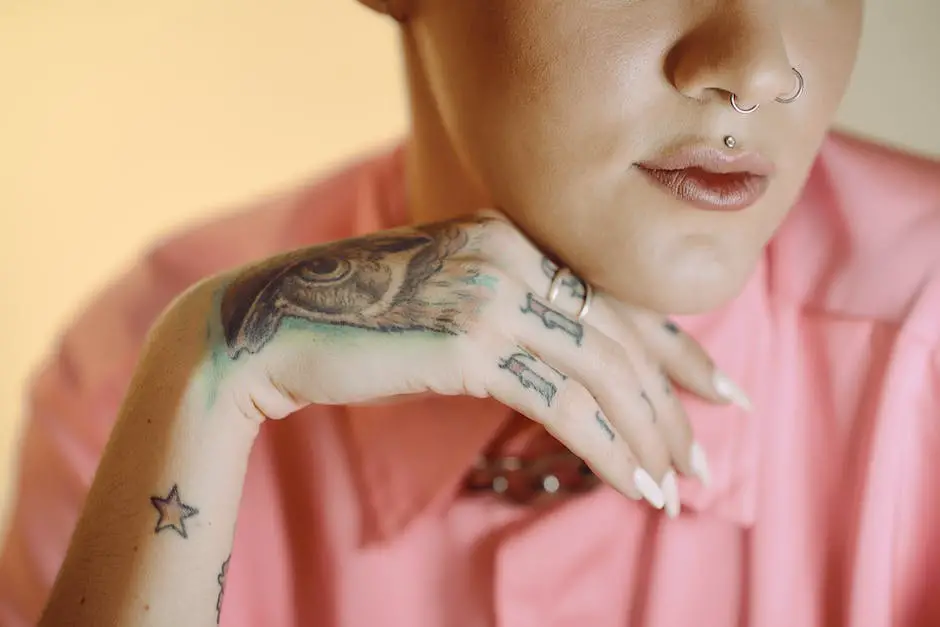I have always been fascinated by body modifications, and one of the most intriguing ones, in my opinion, is septum piercing. The trend has been around for centuries, and its evolution through time reflects cultural and societal changes. In this article, I will explore the history and significance of septum piercing, from its early origins to its current popularity.
Table of Contents
Septum piercing has been a part of different cultures around the world, and its history can be traced back to ancient times. The practice was primarily a cultural and religious custom, and its significance varied depending on the region and society.
As time passed, the trend evolved and gained popularity in the West, becoming a fashion statement and a form of self-expression. Today, septum piercing is a widely accepted form of body modification, and it has become a symbol of individuality and rebellion.
Introduction to the History of Septum Piercing
In this section, I’ll delve into the origins of septum piercing and explore its cultural significance throughout history.
Septum piercing has been around for centuries and has been practiced by various cultures around the world. Its origins can be traced back to ancient African and South Asian cultures, where it was often used as a symbol of status and wealth.
In some cultures, septum piercing was seen as a special event. For example, in Ethiopia, young men would get their septums pierced to show that they were becoming adults. In Hindu culture, young girls got their septums pierced when they became old enough to have babies.
Overall, the symbolism behind septum piercing varies greatly between cultures, but it has consistently been used as a way to express one’s identity and social status.

Ancient Cultures and Their Practices
Let’s journey back in time and explore the fascinating rituals and customs of our ancestors, including their unique body modifications.
Ancient cultures all over the world had their own unique ways of expressing themselves through body modifications. The practice of septum piercing was particularly popular in many ancient cultures, and it was often associated with symbolism and ritual.
In some cultures, getting a septum piercing was important when you became an adult. It was also believed to protect people from bad spirits. Different cultures used different methods for piercing the nose, like using wood or bone, or hot needles.
Despite the differences in technique and symbolism, one thing is clear: septum piercing has been a part of human expression and culture for thousands of years.
Cultural Significance in Different Regions
When it comes to cultural significance in different regions, I find it fascinating to explore the various practices and beliefs surrounding septum piercing in Africa, the Middle East, and Southeast Asia.
In African cultures, septum piercings were often seen as a symbol of wealth and social status.
In the Middle East, they were believed to have protective and healing properties.
In Southeast Asia, septum piercings were commonly used as a form of adornment and were often accompanied by intricate jewelry designs.
Africa
Did you know that nose piercings have been a part of African culture for centuries? The African origins of septum piercing can be traced back to ancient Egypt, where it was believed that the nose was the gateway to the soul.
Nose piercings were also a symbol of wealth and status in some African societies. In some parts of Africa, septum piercings were also used as a form of punishment for criminals.
Traditional variations of septum piercing can vary greatly depending on the region of Africa. For example, in Ethiopia, it’s common for women to wear large, ornate septum rings made of gold or silver. In other regions, septum piercings are simple and may be worn by both men and women.
Regardless of the variation, septum piercing remains an important cultural practice in many parts of Africa.
Middle East
You may be surprised to learn about the rich cultural traditions surrounding body adornment in the Middle East.
Septum piercing, in particular, has been a part of Middle Eastern culture for centuries. Traditional techniques involve piercing the septum with a needle and then inserting a piece of jewelry, which is often made of gold or silver. This practice is still prevalent in many Middle Eastern countries, and it is often done as a rite of passage or to signify a person’s social status.
In recent years, septum piercing has also become a contemporary trend in the Middle East. Many young people are getting their septums pierced as a fashion statement. However, it is important to note that septum piercing still holds religious and spiritual significance for many people in the region.
In Islam, for example, it is believed that the prophet Muhammad had a pierced septum, and some Muslims view it as a way to imitate him. Overall, septum piercing in the Middle East is a perfect example of how body adornment can be both a traditional practice and a modern fashion trend.
Southeast Asia
If you’re looking for new and exciting ways to express your personality through body adornment, you won’t want to miss exploring the diverse cultural traditions of Southeast Asia.
Septum piercing has been a part of Southeast Asian tradition for centuries, and it continues to evolve with contemporary interpretations. Traditional techniques for septum piercing in Southeast Asia involve using a needle or a sharpened bamboo stick to create a hole. The septum is then adorned with various jewelry pieces, such as gold rings or beads.
Today, contemporary interpretations include using a variety of materials, such as silver, brass, and even silicone. Septum piercings are also becoming more popular among younger generations in Southeast Asia, who are incorporating modern designs into their traditional adornment.
Overall, the rich history and evolving nature of septum piercing in Southeast Asia make it a fascinating aspect of body adornment to explore.

The 1970s and the Rise of Western Popularity
You’re transported to the 1970s, where Western pop culture was starting to embrace septum piercings as a daring and fashionable statement. The punk movement of the late 1970s was a major influence on this trend, as it rejected mainstream fashion trends and embraced counterculture styles.
Septum piercings, along with other body modifications, became a way for punks to express their rebellion against the norm. However, this also sparked a cultural appropriation debate, as some argued that these piercings had cultural significance in other parts of the world and should not be appropriated by Westerners.
Despite the controversy, septum piercings continued to gain popularity in the Western world throughout the 1970s and beyond. They were no longer just associated with punk culture but were also embraced by mainstream fashion trends.
Celebrities like Cher and FKA Twigs have been known to sport septum piercings, further popularizing the trend. Today, septum piercings are a common sight on the streets and in fashion magazines, showing how a daring and rebellious statement from the 1970s has become a popular fashion choice.
Modern-day Fashion and Mainstream Acceptance
Nowadays, septum piercing has become a staple in modern fashion and is widely accepted in mainstream culture. It has come a long way from its roots in ancient cultures and its rise in popularity during the 1970s. As someone who’s always been fascinated by body modification, I find it interesting to see how septum piercing has evolved over time.
One of the most significant impacts of septum piercing’s mainstream popularity is its increased accessibility. It’s now easier than ever to find a reputable piercer and high-quality jewelry, making it more accessible to people from all walks of life.
However, with this accessibility comes the issue of cultural appropriation. As septum piercing becomes more mainstream, it’s essential to acknowledge and respect its cultural significance in various communities and not just treat it as a trendy fashion statement.
To paint a picture of the current state of septum piercing, here are four observations:
1. Septum piercing is now commonly seen on celebrities, fashion models, and influencers, and it’s often featured in fashion magazines and advertisements.
2. There’s a growing demand for unique and personalized jewelry, with many designers creating septum-specific pieces.
3. The practice of DIY septum piercing is still prevalent, despite the potential risks and dangers.
4. There are ongoing discussions and debates about cultural appropriation and the commodification of septum piercing in mainstream culture.

Different Styles and Types of Septum Piercing
As someone who’s interested in body modification, you may find it intriguing to explore the various styles and types of septum piercing that are popular today, each with its own unique flair and aesthetic. From the classic captive bead ring to the more recent trend of septum clickers, the possibilities for septum piercing jewelry are endless. Whether you prefer a minimalistic, understated look or something bold and attention-grabbing, there’s sure to be a style that suits your taste.
It is important to take care of any piercing, including a septum piercing. Make sure it does not get infected by cleaning the piercing twice every day with a saline solution or special aftercare spray.
It’s also important to avoid touching the piercing with dirty hands and to avoid submerging it in bodies of water, such as pools or lakes. By following these aftercare tips and choosing the right style of septum piercing jewelry, you can enjoy your piercing for years to come.
| Type of Jewelry | Description | Pros | Cons |
| Captive Bead Ring | A circular ring with a small bead that clips onto the ring | Classic and versatile. Easy to change out beads for different looks | Can be uncomfortable if the bead is too tight |
| Septum Clicker | A hinged ring with a decorative centerpiece that clicks into place | Easy to put in and take out. Many unique designs are available | More expensive than other types of jewelry |
| Circular Barbell | A circular ring with a straight bar that goes through it | Can be worn with multiple piercings. Offers a more subtle look | Can be difficult to put in and take out |
| Retainer | A clear or flesh-colored piece of jewelry that keeps the piercing open | Great for work or situations where a more discreet look is required | Can be uncomfortable to wear for extended periods of time |
Risks and Considerations
Before getting any type of jewelry for your septum piercing, it’s important to be aware of the potential risks and considerations involved to ensure that you make a well-informed decision. Here are some things to keep in mind:
1. Healing time is different for everyone and depends on what kind of piercing you have. It can take from 6 weeks to 6 months to heal completely. During this time, avoid touching or moving the jewelry so you do not get an infection or become irritated.
2. Aftercare tips are crucial to maintaining the health of your piercing. This includes cleaning the area with saline solution or mild soap and water, avoiding harsh chemicals and makeup around the piercing, and avoiding swimming or soaking in water until the piercing is fully healed.
3. Septum piercing carries a risk of infection, which can be avoided by ensuring that the piercing is done by a professional using sterile equipment and jewelry.
4. Considerations should also include personal style and comfort. It’s important to choose jewelry that fits your aesthetic and is comfortable for daily wear.
By keeping these risks and considerations in mind, you can make an informed decision about whether septum piercing is right for you and ensure that you take the necessary steps to care for your piercing during the healing process.
Final Thoughts
Reflecting on the previous subtopic, it’s clear that septum piercing is not without its risks and considerations. However, as with any body modification, the decision to get one should ultimately be a personal one.
For me, my septum piercing is a reflection of my identity and personal style. It’s a symbol of my individuality and a way for me to express myself.
In my personal experience, getting my septum pierced was a transformative moment. It was a decision I made for myself, and it has since become a part of who I am.
The process itself was quick and relatively painless, and the healing process was not as difficult as I had anticipated.
Overall, my septum piercing has been a positive addition to my life, and I have no regrets about getting it.

After all, researching the history of septum piercing has been an eye-opening experience. I never knew that such a simple act of piercing one’s septum could hold such cultural significance and be practiced by so many different ancient civilizations.
It has been fascinating to learn about the evolution of this practice and how it has evolved over time to be a fashion statement in modern times. As someone who’s always been interested in body modification, I found this research to be both informative and entertaining.
I hope that others can appreciate the rich history and significance behind septum piercing and that it continues to be a form of self-expression for people all over the world.
